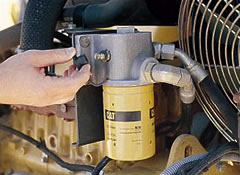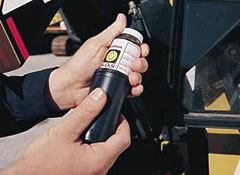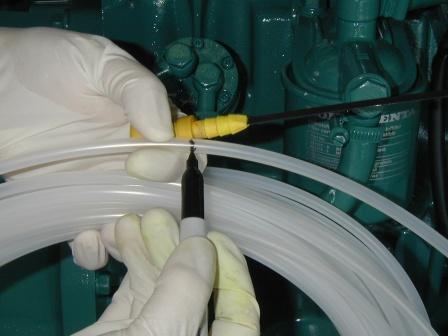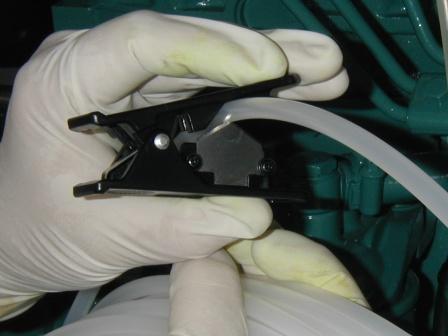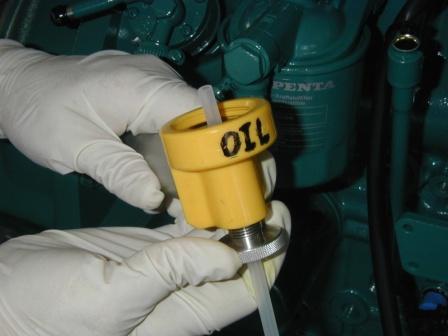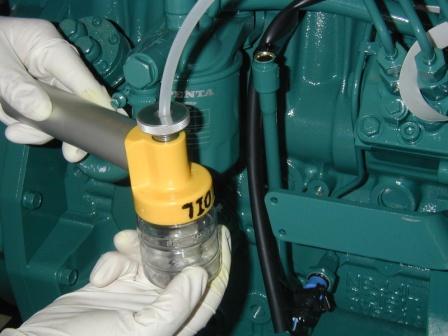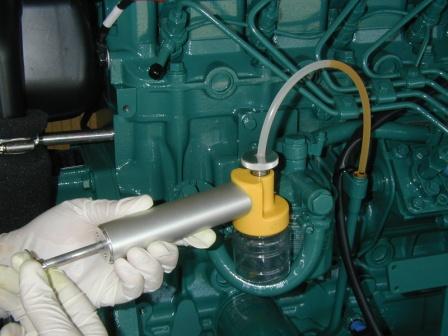PATH: Boat Building & Refitting » Boat Eq » Propulsion » Engines » Lubrication » Oil » Analysis »
PATH: Do-It-Yourself » DIY Boat Building & Refitting » ∧ »
PATH: Media › Creators » Documentation, Books, Magazines, Videos, Websites » ∧ »
PAGE CONTENTS: (click ⇒ to go to each section on this page)
⇒ Topic Treatment: Introduction, Overview, Background, Details, Directories,+.
⇒ ^ Related Resources: EAB Topics w/Directories, Vendors, Products: Media: Books, Websites,+.
⇒ Visit EAB's FEATURED ARTICLES Home Page to preview the vast scope of our website.
⇒ This Month's Top 20 Most Popular Articles on our EAB website.
⇒ Layout of the EverythingAboutBoats.org Website's Pages: Page Types, Contents, Topics,+.
⇒ What our nonprofit Anchors Aweigh Academy and its EAB website have accomplished.
⇒ Members must SIGN IN to gain access to Members Only areas of this website.
⇒ Become an Academy Member and gain access to additional pages and programs!
⇒ Comments: Submit To ⇒ Comments♥EverythingAboutBoats.org (Replace "♥" with "@").
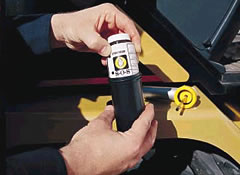
It is always best to take the oil sample immediately after running a fully warmed up engine, so the oil is thoroughly mixed and everything that is in the oil, especially contaminants, are evenly “in suspension”.
In the event that the engine cannot be run for some reason, then the entire oil sump must be drained into a perfectly clean container and the entire container of used oil will have to be processed so the sample will be more representative (usually at an additional cost to stir up the contents and draw the sample), but unfortunately, far too often the analysis readings will be skewed enough to be misleading. Yet, this may prove useful in determining if a serious problem exists such as fuel dilution of the oil due to a leaky injector or fuel pump, or coolant contamination from a “blown” head gasket. Go to Engine Oil Analysis for a full interpretation of oil analysis results.
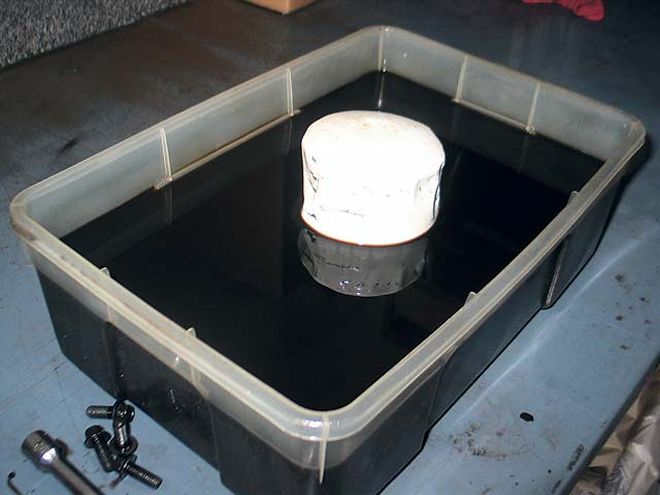 This oil was undoubtedly contaminated by the oil filter!
This oil was undoubtedly contaminated by the oil filter!
Taking samples from either the drain stream, the waste oil container, or the used filter is the least desirable method of obtaining an engine oil sample, as doing so more often then not results in an unrepresentative sample. The used oil filter usually contains high concentrations of contaminants that will throw off the analysis. The waste oil container may already be contaminated or it can easily become contaminated by falling debris. Then there is the sampling of the drain stream. In the early days of oil analysis, it was believed that a good sample could be “caught mid-stream” as the oil was draining from the oil sump (on most engines the oil pan acts as the sump). The sample was caught, not at the beginning of the draining and not near the end, but mid-way between (mid-stream, like at the doctors office). It was quickly realized however that a sample from the drain stream often contained high concentrations of contaminants from the bottom of the sump and the drain plug hole surroundings, (e.g. metal from the threads,+), so better methods of taking a sample had to be developed.
Oil Sampling Probe
The most preferred method of taking an engine oil sample is with an oil sampling probe. If the engine is not equipped with an oil sampling probe valve, one can usually be installed. The valve is available from most large engine dealers. The probe valve allows a probe to be inserted while the engine is running, and the engine’s own oil pump will pump oil through the probe into the sample bottle. Just remember to reinstall the probe valve cap to keep the valve clean for the next sampling.
This sampling method requires a Brass Probe (like a Cat # 8T9208) and approximately 15 cm (6 in) of tubing (like Cat # 6K0713 or 5P6442 bulk cut to length). Some sample kits may already come with a disposable probe and tubing.
The process of taking an oil sample by an oil sampling probe is as follows:
1 – After the engine you are going to sample has been started and has been running long enough for the engine to warm up. set the engine at low idle and remove the dust cap from the oil sampling probe valve on the engine.
2 – Insert the probe into the valve and collect about 100 ml (4 fl oz) of oil into a small waste container. This will clean the valve and helps ensure a representative sample. Dispose of the waste oil properly. If the oil flow is slow at low idle, it may be necessary to have someone accelerate the engine to a higher idle while clearing the valve and extracting the sample.
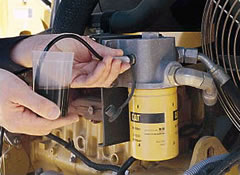
3 – Insert the probe into the valve again and this time fill the sample bottle to the proper level (usually one-half to three-quarters full). Do not fill to the top. Do not allow any dirt to enter the bottle or contaminate the inside of the bottle’s cap.
4 – Withdraw the probe from the valve and secure the sample bottle cap tightly. otherwise, it can make a real mess inside the shipping cylinder. Make sure that the sample bottle’s outside is clean and place the bottle with the completed label into the shipping cylinder.
5 – Don’t forget to reinstall the probe valve dust cap.
From MacAllister Machinery
Vacuum Extraction
Vacuum Extraction is the most recommended method of taking an oil sample if the engine is not equipped with an oil sampling probe valve. With vacuum extraction, a length of clean plastic tubing is inserted into the oil sump (usually down the dipstick hole) about half way into the oil and the oil is drawn up the tube into the sample bottle by the vacuum created in the bottle by a hand operated vacuum pump. The equipment needed include the vacuum pump, a sample bottle, a length of sterile extraction tubing, and a clean tubing cutter. These items are readily available from many sources including most engine dealers, engine service shops, and oil analysis laboratories. Some engines (like Hino 4 & 6 cylinder diesels) require a smaller (3/16″ O.D.) diameter tubing to fit into their smaller I.D. dipstick tube. This smaller tubing is often stocked at local hardware stores or can be ordered. The hand vacuum pump’s knurled tubing sealing nut usually has no problem compressing the tubing sealing “O” ring enough to seal the smaller diameter tubing into the vacuum pump. Always store the vacuum pump, the clean new extraction tubing, and the tubing cutter, each in a clean place such as in clean heavy Zip-Lock type storage/freezer bags.
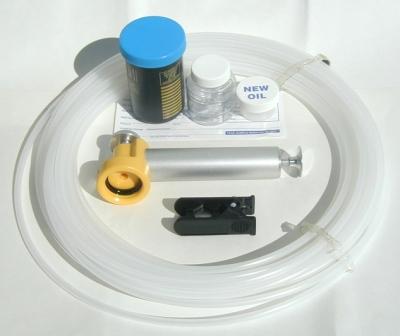
NOTE: You may want to wear mechanics gloves or surgical gloves (as shown below) to protect your hands and facilitate cleanup afterwards.
The process of taking an oil sample by Vacuum Extraction is as follows:
1 – Ensure that the engine has been properly warmed up, so the oil is thoroughly mixed and everything in the oil, especially contaminants, are “in suspension”.
2 – Cut about a half-inch of tubing off the loose end of the new tubing roll with a clean cutter to rid the tubing of any contamination that may have drifted inside the end. The roll of sterile extraction tubing should be stored in a clean Zip-Lock type bag until needed.
3 – Mark the new tubing to the length of the dipstick (tip to seal). This mark will be used later when inserting the tubing through the engine’s dipstick hole into the engine’s oil sump to reach the proper depth in the oil.
4 – From this mark add enough tubing to reach the vacuum pump when held upright and cut with a clean cutter. Cutting the tubing with a pocket knife is not only difficult and dangerous but can introduce particles that may contaminate the sample. Do NOT let the tubing (especially the ends) touch anything and become contaminated. Store the unused and still sterile extraction tubing and the tubing cutter, each in a clean container such as a clean Zip-Lock type bag.
5 – Insert the tubing into the head of the vacuum pump until it extends about a half-inch beyond the pump base and gently tighten the knurled tubing sealing nut.
6 – Remove the lid from the new sampling bottle and screw the bottle onto the pump. Protect the lid so it does not become contaminated. Try to keep the length of time that the lid is off the bottle to a minimum.
7 – Insert the extraction tubing into the engine’s dipstick tube to the mark made earlier. This should put the end of the tubing a couple of inches below the surface of the oil in the sump. The tubing may have to be inserted further if the oil level is low, but don’t let the tubing touch the bottom of the sump where it can pick up concentrated contaminates.
8 – Hold the pump upright and slowly pull the pump handle to draw the oil. Fill the bottle to the proper level (usually about one-half to three-quarters full). Release any vacuum in the bottle by loosening the knurled tubing retaining nut or opening the vacuum release valve (if the pump is so equipped) so that the bottle does not overfill.
9 – It is usually acceptable to remove the tubing from the vacuum pump and let the oil still in the tubing drain back into the engine sump since the oil should not have become contaminated during this process..
10 – Unscrew the sample bottle from the pump and screw the lid on the bottle. Make sure the bottle exterior is clean and insert it into the mailing cylinder with the completed label. Many labs recommend that a sample of unused oil saved from the same batch as was drawn from the engine, be sent to the lab to be used as a reference in the analysis. The sampling kit may include a “New Oil” sample bottle that will fit in the mailing cylinder with the drawn sample.
11 – Withdraw the used extraction tubing from the engine and properly dispose of it. Zip-Lock type bags are very handy for this. Never reuse the tubing.
A Note: Wearing clean gloves will help keep you and your sampling equipment clean.
An Important Note: If the pump requires internal cleaning, it can be flushed with fresh, clean engine oil. Do not use solvents as they can skew an oil sample’s lab results.
A Very Important Note: Never use the same vacuum pump for extracting a coolant sample and later an oil sample. Glycol vapor can collect as a residue in the vacuum pump and can contaminate later oil samples causing a “false positive” for antifreeze contamination. Always use separate dedicated pumps for oil and for coolant.
Documentation
If you can help us add information, Catalogs, Brochures, Spec Sheets, Pictures, OpManuals, Parts Lists, Shop Manuals, etc. that we lack, please submit the info or link in the Comment Box below, or attach the PDF to an email to the Editor♥EverythingAboutBoats.org (Replace “♥” with “@”). Thanks!
Catalogs:
- +
Brochures:
- Caterpillar:
^ Cat S•O•S Services.
^ The Value of Cat® S•O•S Services.
^ How to Sample Oil & Coolant.
^ Fuel Sampling Guide.
^ How to Read Your Results. - Butler Machinary:
^ Oil Analysis II & III.
SpecSheets/Data Sheets:
- +
Charts and Graphs:
- +
Pictures:
- +
Press Releases:
- +
Owner’s/Operator’s Manuals:
- +
Parts Schematics with Exploded Views & Parts Lists:
- +
Parts Bulletins:
- +
Service Bulletins:
Product Recalls:
- +
Training Videos:
Publications & Media:
If you think we should add a Book, Magazine, Article, Website & Video to this webpage,
please submit the Link in the Comment Box below or via email to
the Editor♥EverythingAboutBoats.org (Replace “♥” with “@”). Thanks!
More Books, Magazines, Articles, Websites & Videos may be found at Propulsion Machinery, Engines,
DIY: Propulsion Machinery, DIY: Engines, and the main AEABoats _Mfr_ webpage.
Publications, etc. with BOLD Titles are part of our Academy eLibrary. To view the Publication, etc. as a PDF, click on the BOLD Title Link below.
If you would like to donate a Book, Magazine or Video to our Academy eLibrary,
please email Donations#AnchorsAweighAcademy.org to arrange.
Books:
- +
Magazines:
- The ANCHOR (Anchors Aweigh Academy).
- DIY_Boat_Owner – The Marine Maintenance Magazine.
^ Oil Test: Troubleshooting with Oil Analysis (2003 #3 Page 20).
Articles:
Websites:
- Apex Oil Lab:
^ Used Oil Sampling Techniques – Good Oil Sampling for Good Results. - Blackstone Laboratories:
^ Sampling Procedures. - Bureau Veritas:
^ Taking Oil Samples. - Caterpillar:
^ Half a Century of Fluid Analysis Expertise.
^ Value of Fluid Analysis.
^ Fluid Analysis 101.
^ Fluid Analysis for Mixed Fleets. - Checkfluid:
^ Getting A Proper Oil Sample.
^ Take Better Oil Samples. - Machinery Lubrication:
^ Oil Sampling Do’s and Don’ts.
^ Download Oil Analysis Training. - Spectro Scientific: Oil Analysis Instruments To Fleets & Industry Worldwide.
^ Download Fluid Analysis Solutions Catalog.
^ Download Free Oil Analysis Handbook.
Videos:
EverythingAboutBoats.org
Related Webpages
EverythingAboutBoats.org
Main Topic Page Links
BOAT REFITTING & REPAIR
^ Refitters: Countries by Regions (Shipyards, Boatyards, Riggers, Repair Shops,+)
^ Boat Repair Schools (Hull, Systems, On-Board Equipment, Propulsion Machinery,+)
^ Do-It-Yourself Refitting (Installation, Maintenance, Troubleshooting, Repair,+)
^ ^ DIY: Fundamentals
^ ^ ^ DIY: Tools, Usage, Safety, etc
^ ^ ^ DIY: Rot, Corrosion, Fatigue, etc
^ ^ ^ DIY: Troubleshooting, Failure Analysis, etc
^ ^ DIY: Vessel Structure
^ ^ DIY: Propulsion Machinery (Control Systems,+)
^ ^ ^ DIY: Engines (Fuels, Troubleshooting, Repair, Rebuilding vs Repowering,+)
^ ^ ^ ^ DIY: Engine Mechanical (Pistons, Rods, Crankshafts, Blocks, Heads, Valves,+)
^ ^ ^ ^ DIY: Engine Lubrication (Splash, Forced, Oil, Filtration, Additives, Oil Analysis,+)
^ ^ ^ ^ Engine Oil Fundamentals
^ ^ ^ ^ ^ Engine Oil Analysis
^ ^ ^ ^ ^ ^ Taking a proper engine oil sample for analysis
^ ^ ^ ^ DIY: Engine Fuel (Petrol/Gasoline, Diesel, CNG,+)
^ ^ ^ ^ DIY: Engine Electrical (Starting, Charging, Instrumentation,+)
^ ^ ^ ^ DIY: Engine Cooling (Air, Raw, Fresh,+)
^ ^ ^ ^ DIY: Engine Exhaust (Dry, Wet,+)
^ ^ ^ ^ DIY: Engine Mounting (Hard, Soft,+)
^ ^ ^ DIY: Engine-to-Marine Gear Interfaces (Adapter Plates, Damper Plates, Jackshafts,+)
^ ^ ^ DIY: Marine Gears (Inboards, Inboard-Outboards, Outboards, Sail Drives, Pods,+)
^ ^ ^ DIY: Shafting (Shafts, Couplings, CVC Joints, Thrust Bearings, Seals, Cutlass, Struts,+)
^ ^ ^ DIY: Propellers (Screws, Water Jets, Paddle wheels,+)
EVERYTHING ON THIS PAGE OK?
If there is anything on this webpage that needs fixing, please let us know via email To:
Editor♥EverythingAboutBoats.org (Replace "♥" with "@")
THIS ARTICLE IS STILL EVOLVING!
The page may contain rough drafts that include raw source materials.

Visit our FEATURED ARTICLES Home Page
to see examples of our website's comprehensive contents!
Thanks to our amazing contributors for the steady flow of articles, and to our dedicated all-volunteer staff who sort, polish and format them, everyday we get a little bit closer to our goal of
Everything About Boats. If you would like to submit an article,
See Submitting Articles.
— TOP 20 MOST POPULAR ARTICLES —
Detroit Diesel 8.2 Liter “Fuel Pincher” V8 Engine
Cummins V-555 & VT-555 “Triple-Nickel” V8 Diesel Engine
Lehman 120 (6D380) Diesel Engine (Ford 2704C & 2715E)
Ford Industrial Power Products Diesel Engines
How to Identify Ford Diesel Engines
Ford 2715E Diesel Engine
Lehman Mfg. Co.
Perkins Engines
Universal Atomic 4
Sears Boat Motors: Motorgo, Waterwitch, Elgin, etc.
Chrysler & Force Outboards
Eska Outboard Motors
Allison Transmission
ZF Friedrichshafen AG
Marine Surveyors by Country
American Marine Ltd (Grand Banks)
Boat Inspection (Types of Marine Surveys)
Boat Builders: (A∼Z) (w/Vessel Types, Locale & Years Active)
USCG NVIC 07-95 Guidance on Inspection, Repair and Maintenance of Wooden Hulls
American Boat and Yacht Counsel (ABYC)
Layout of the EverythingAboutBoats.org Website's Pages
— Types of Webpages —
This website consists almost entirely of 3 types of webpages as follows:
- TOPIC PAGES (See Main Topic Pages listed on Website Contents or the Right Sidebar) ⇒
- EXAMPLE: – WEBSITE CONTENTS w/Links to MAIN TOPIC & Subtopic Pages:
- EXAMPLE: 02 – BOAT BUILDING, OUTFITTING, REFITTING & REPAIR:
- EXAMPLE: 02.06 – Boat Equipment:
- EXAMPLE: 02.06.08 – Propulsion Machinery:
- EXAMPLE: 02.06.08.01 – Engines w/Directory of Vendors.
- VENDOR PAGES (Vendors of Products, Services, Events,+, Destinations & Media Creators)
- EXAMPLE: 02.06.08.01 – ^ Ford Industrial Power Products Diesel Engines.
- PRODUCT PAGES (Equipment, Events, Media: pDoc, Books, Magazines, Videos, Websites,+)
- EXAMPLE: 02.06.08.01 – ^ ^ Ford 2715E Diesel Engine.
- EXAMPLE: 02.06.08.01 – ^ ^ Ford OpManual - 2710 Range Diesel Engines.
- EXAMPLE: 02.06.08.01 – ^ ^ Ford Service Manual - 2700 & 2710 Range Diesel Engines.
Clickable Links that lead to other webpages appear in Blue Text and usually open in a new window.
Links in the Right Sidebar and most directories open in the current window, not a new window.
Note in the examples above that these pages form a natural hierarchy.
The unnumbered "^" pages are listed alphabetically in most tables.
Media Titles in tables are distinguished by their smaller font size.
Media (Books, Magazines, Videos, Articles,+) are treated as Products.
Vendors' Product Documentation (pDoc) are considered Media.
Destinations & Media Creators are treated as Vendors.
All Website Pages are optimized for viewing on
full-width disktop computer monitors,
but can be viewed on phones.
— Contents of Webpages —
Website Pages typically contain the following Sections:
- PATH (Shows the chain of EAB pages w/links that lead to the page being viewed).
- EXAMPLE:
PATH: HOME, WEBSITE INDEX, WEBSITE CONTENTS » ∨
∧ BOAT BUILDING & REPAIR » Boat Equipment » Propulsion » Engines » ∨∨
∧∧ Ford, Ebro, American Diesel, AmMarine, Barr, Beta, Bomac, Bowman, Couach,
Lees, Lehman, Mermaid, Parsons, Renault, Sabre, Thornycroft, Wortham Blake »
∧ DO-IT-YOURSELF » DIY Boat Building & Repair » DIY Schools & Classes »
∧ MEDIA w/Creator Directory » Documentation, Books, Magazines, Videos, Websites » - (The "»" right pointing Guillemet symbol shows the chain through the page links.)
- (The "," comma between page links in the chain indicates pages are not subordinate, but are instead at the same level. See engine brands in the example above.)
- (The "∨", "∨∨", "∨∨∨",+ symbols indicate that the path line continues with whatever follows the "∧", "∧∧", "∧∧∧",+ symbols respectively. "∧" Precedes each MAIN TOPIC Page.)
- EXAMPLE:
- PAGE CONTENTS (Table of Contents with links to each main section on the page).
- PAGE BODY (The type of page determines the contents of its body as follows:).
- TOPIC PAGES (Topic Treatment: Introduction, Overview, Background, Details,+).
- (Many Topic Pages contain Directories of Vendors with Links).
- (Most Directory Listings are Alphabetical and/or by Locale).
- VENDOR PAGES (Vendor's Profile, Contact Information, Products, Services,+).
- (Manufacturers, Resellers, Refitters, Yards, Surveyors, Clubs, Schools, Authors,+).
- (Boating & Travel Destinations are treated as Vendors on their own Vendor Pages).
- PRODUCT PAGES (Product Features, Vendor Links, Specifications, Documentation,+).
- (Media created by a vendor is often treated as a Product on its own Product Page).
- (Boating & Travel Events are often treated as Products on their own Product Pages).
- TOPIC PAGES (Topic Treatment: Introduction, Overview, Background, Details,+).
- RELATED RESOURCES (Topics, Vendors, Products, Media: Books, Websites,+ with Links).
- PAGE TAIL Contains the following Anchors Aweigh Academy & EAB Website Features:
- The Anchors Aweigh Academy's EverythingAboutBoats.org Header.
- A link to our Featured Articles EAB Home Page.
- Top 20 Most Popular Articles. (The section that appears right above ⇑ this section).
- Layout of the EverythingAboutBoats.org Website's Pages. (This very section ⇐).
- Topics of Webpages. (The very next section below ⇓).
- What we have accomplished so far.
- Members must Sign-In to gain full access to Expanded Pages & Programs.
- Sign-Up (if not already a member).
- Public Comments (about the website & about this page).
- RIGHT SIDEBAR (Website Contents menu with links to Main Topic & Subtopic pages).
(On some smart phones, the Right Sidebar may appear at the bottom of the webpage)
— Topics of Webpages —
Website Pages are categorized under the following 16 MAIN TOPICS:
The MAIN TOPICS follow a natural progression from conception of the vessel thru its
building, marketing, survey, financing, insuring, transport, moorage, use and upkeep.
The MAIN TOPICS (all Caps) below are followed by their Main Subtopics with Links.
00 – HOME: CONTENTS, ABOUT EAB: Contact EAB, Abbreviations & Symbols, FAQ, GLOSSARY, ADs,+.
01 – ABOUT BOATS w/Museum Directory: Early History, Recent History, Modern Vessel Types,+.
02 – BOAT BUILDING, OUTFITTING, REFITTING & REPAIR: Materials, Equipment, Builders,+.
03 – BOAT MARKETING: Boat Shows, Dealers & Brokers, Importing & Exporting, Auctions & Sales,+.
04 – BOAT INSPECTION: Types of Marine Surveys, Marine Surveyors, Schools, DIY Inspections,+.
05 – BOAT TITLES & VESSEL REGISTRY: Boat Title & Registration, Vessel Registry, Title Co's,+.
06 – BOAT FINANCING: Conventional (Banks, Credit Unions,+), Unconventional (Creative),+.
07 – BOAT INSURANCE: Maritime & Recreational: Coverage, Carriers, Agents,+., Claim Processing,+.
08 – BOAT TRANSPORT: By Sea (Piggyback, Delivery Skippers & Crews, & Towing), Over-Land,+.
09 – BOAT HAULING & LAUNCHING: Drydocks, Ways, Lifts, Cranes & Hoists, Launch Ramps,+.
10 – BOAT MOORAGE & STORAGE: Builders, Anchorages, Marinas, Yards, Racks & Stacks,+.
11 – BOATING ORGANIZATIONS: Yacht Clubs & Sailing Clubs, Paddling Clubs, Boat Owners,+.
12 – BOATING & TRAVEL: Events, Destinations, Boat Rentals & Charters, Cruises, Voyages,+.
13 – BOATING & MARITIME EDUCATION: Recreational Seamanship, Ship's Master & Crew,+.
14 – MARINE LAWS & REGULATIONS: International & National Laws‚ Lawyers‚ Investigators‚+.
15 – DO-IT-YOURSELF: DIY Boat Building & Repair, DIY Boat Sales, DIY Boat Surveys, DIY Classes,+.
16 – MEDIA w/Creator Directory + Academy eLibrary: pDocs, Books, Magazines, Videos, Websites,+.
The above MAIN TOPICS and a more detailed listing of Subtopics
can be found on the Website Contents page and on the Right Sidebar.
An Alphabetical Index of the website can be accessed at Website Index.
What we have accomplished so far.
Anchors Aweigh Academy and its EverythingAboutBoats.org website.
- Published over 50,000 website pages about boats and boating, bringing us closer to reaching our goal of becoming "The ultimate reference resource about boats and ships for everyone from the beginning recreational boater to the seasoned professional mariner!"
- Published over 300 website main topic webpages, many with full articles on the topic. See our Website Contents or the Right Sidebar for the listing of the main topic pages.
- Published over 9,000 marine vendor webpages, all with their contact information, most with a description of their products and services, many with product documentation, specifications and independent reviews. (incl.: Boat designers, boat building tools, material and equipment manufacturers and suppliers, boat builders and dealers, yacht brokers, marine surveyors, boat insurers, boat transporters, skippers and crews, boatyards and marinas, yacht clubs, boat rentals and yacht charters, boating, seamanship and maritime schools, marine law attorneys and expert witnesses, boat refitters and repairers, book authors, magazine publishers, video producers, and website creators)
- Acquired over 120,000 pages of product documentation including Catalogs, Brochures, SpecSheets, Pictures, Serial Number Guides, Installation Manuals, OpManuals, Parts Catalogs, Parts Bulletins, Shop Manuals, Wiring Diagrams, Service Bulletins, and Recalls. And have made all viewable to Academy Members through our EAB website eLibrary.
- Acquired over 1,200 books and magazine back issues in our academy library and so far have made over 700 viewable to Academy Members through our EAB website eLibrary.
- Published over 500 DIY How-To articles about boat design, construction, inspection, operation, maintenance, troubleshooting and repair. We are working hard to do more.
We are currently formatting and polishing the Anchors Aweigh Academy online and hands-on courses. Our Marine Surveying course has proven to be excellent for both the beginner and the seasoned surveyor, and especially helpful to the Do-It-Yourselfer.
Current Academy Members must SIGN IN to gain FULL access to this
website including expanded pages and valuable Academy programs
like our Academy eLibrary and our Ask-An-Expert Program!
If your membership has expired, CLICK HERE to Renew.
IF YOU ARE NOT YET AN ANCHORS AWEIGH ACADEMY MEMBER,
CLICK HERE to discover how you can become a Member and gain FULL access to
thousands of expanded pages and articles, and dozens of excellent programs
WITH JUST A SMALL DONATION!
Comments for Public Viewing
Submit any comments for public viewing via email To: Comments♥EverthingAboutBoats.org (Replace "♥" with "@")
Please remember to put this webpage's title in the subject line of your email.
All comments are moderated before they appear on this page. See Comment Rules.
General Comments About the Website
FROM Donald: "This is an awesome website. I found the information that I needed right away from one of the over 20,000 free articles that you provide as a public service. I'm surprised that so much if this site is free. But I still signed up so I could access the thousands of expanded pages, interesting articles, and dozens of valuable programs! The member's library of books, magazines and videos that I can view online is really terrific! I understand that you and your staff are all unpaid volunteers. Please keep up the good work. And I commend you for your plans to add another 10,000 free informative articles over the next year. I'm thrilled to support you in this endeavor with my small membership donation. Thanks again for all your hard work."
FROM Huey: "I agree with my Uncle, I too have found the articles to be very enlightening. They say that it will take about 100,000 articles to cover the full scope that they have envisioned for the website. They have over 20,000 articles so far and that's doing pretty well, but it could take several years to get the rest. I also noticed that many of the Main Topic Pages and some of the article pages are still in the rough draft stage. I guess that they will fill in as they can get volunteers to work on them. But what I can't figure out is why anyone would spend the time writing informative in depth articles just to give away free to this website for publication? What's in it for them?"
FROM Dewey: "Well Huey, to me It looks like most of the articles on this website are written by very informed people, like boating instructors, boat designers, boat builders, riggers, electricians, fitters, marine repair technicians and marine surveyors. Writing such articles helps establish them as knowledgeable professionals. After all, this website was originally created by a school for marine technicians and marine surveyors. The website is growing in content every day. They even had to move to a bigger, more powerful server because the website's traffic has been growing exponentially."
FROM Louie: "I agree with everyone above. This site is quickly becoming the ultimate reference resource about every aspect of boats and ships for everyone from the beginning recreational boater to the seasoned professional mariner. I use the topic pages on the right sidebar to browse around the website. It's like a Junior Woodchucks' Guidebook for Boaters. Their Members' Library of over 300 popular and obscure books and over 200 magazine back issues that can be viewed online is fabulous. The Academy's magazine is especially informative. On top of that, there is the "Ask-An-Expert program for members where you can get an expert's answer to any of your boat questions. And a whole years membership is only $25. What a deal! I really love being part of this "Everything About Boats" community and help provide thousands of helpful articles free to the public. I think that I'll sit down right now and write an article about my experiences boating with my uncle."
FROM Scrooge: "You rave about this website like it was the best thing since sliced bread. Well, I think it stinks. Sure, it has a lot of good information for boaters, and they're adding more every day, but it will probably never be finished. Furthermore, I don't even own a boat. And I wouldn't have a boat even if someone gave me one. Boats are a waste of money and time and energy and money! They're just a hole in the water you pour money into. If you gave me a boat, I'd sell it quicker then you could say Baggywrinkle. Then I'd lock up the cash with all my other money so I could keep my eye on it and count it every day. Bah humbug."
FROM Daisy: "I'm just so glad that Donald got the boat so we and the boys could enjoy boating — together. And of course all of the girls, April, May, and June, love to be on the water too, especially when that is where the boys are. Oh poor Scrooge, boating is more fun then you could possibly imagine."
FROM Scrooge: "After seeing how much fun you all have on the water together, I regret that I didn't have that much fun when I was young. I've had a change of heart, and I'm giving each of you a Lifetime Academy Membership."
FROM Editor: "For those of you that have stayed with us this far, many thanks, and we hope that you found this little narrative informative. Your faithful support inspires us to keep working on this phenomenal website. We know that we have a lot more to do. Ultimately, we hope that we can help you enjoy the wonder filled world of boating as much as we do. We are all waiting to see what you have to say about this webpage article. Submit any comments via email To: Comments♥EverythingAboutBoats.org (Replace "♥" with "@"). Be sure to include this page's title in the subject line. Also, your corrections, updates, additions and suggestions are welcomed. Please submit them via email To: Editor♥EverythingAboutBoats.org (Replace "♥" with "@"). It has been truly amazing to see what we have been able to accomplished when we've worked together. Thanks to all those that have donated their valuable time and energy, and a special THANK YOU to all that have supported this cause with their membership donations."
Comments About This Particular Page
FROM ΞNameΞ: “Be_the_next_to_comment_about_this_page.” {230316}
